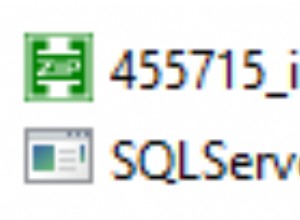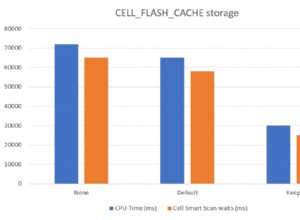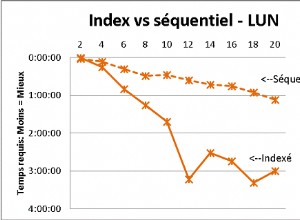Ich nehme an, dies sollte dazu führen, dass "Null assoziatives Array" gedruckt wird. Diese Annahme ist für assoziative Arrays falsch. Sie existieren, wenn sie deklariert werden, sind aber leer. Für andere Arten von PL/SQL-Sammlungen wäre es richtig:
Vergleichen Sie:
SQL> declare
2 type varchar2_100_aa is table of varchar2(100) index by binary_integer;
3 test varchar2_100_aa;
4 begin
5 test(1) := 'Hello';
6 dbms_output.put_line(test(1));
7 end;
8 /
Hello
PL/SQL procedure successfully completed.
SQL> declare
2 type varchar2_100_va is varray(100) of varchar2(100);
3 test varchar2_100_va;
4 begin
5 test(1) := 'Hello';
6 dbms_output.put_line(test(1));
7 end;
8 /
declare
*
ERROR at line 1:
ORA-06531: Reference to uninitialized collection
ORA-06512: at line 5
Variablen-Array richtig gemacht:
SQL> declare
2 type varchar2_100_va is varray(10) of varchar2(100);
3 test varchar2_100_va;
4 begin
5 test := varchar2_100_va(); -- not needed on associative array
6 test.extend; -- not needed on associative array
7 test(1) := 'Hello';
8 dbms_output.put_line(test(1));
9 end;
10 /
Hello
PL/SQL procedure successfully completed.
Weil das assoziative Array first leer ist und last sind null, weshalb Ihr zweites Beispiel zu ORA-06502: PL/SQL: Numeric or value error führt :
SQL> declare
2 type varchar2_100_aa is table of varchar2(100) index by binary_integer;
3 test varchar2_100_aa;
4 begin
5 dbms_output.put_line(test.count);
6 dbms_output.put_line(coalesce(to_char(test.first), 'NULL'));
7 dbms_output.put_line(coalesce(to_char(test.last), 'NULL'));
8 test(1) := 'Hello';
9 dbms_output.new_line;
10 dbms_output.put_line(test.count);
11 dbms_output.put_line(coalesce(to_char(test.first), 'NULL'));
12 dbms_output.put_line(coalesce(to_char(test.last), 'NULL'));
13 end;
14 /
0
NULL
NULL
1
1
1
PL/SQL procedure successfully completed.
BEARBEITEN Beachten Sie auch, dass assoziative Arrays spärlich sein können. Schleife über die Zahlen zwischen first und last löst eine Ausnahme für jede Sammlung aus, die spärlich ist. Verwenden Sie stattdessen first und next
etwa so:(Last und prev um in die andere Richtung zu schleifen.)
SQL> declare
2 type varchar2_100_aa is table of varchar2(100) index by binary_integer;
3 test varchar2_100_aa;
4 i binary_integer;
5 begin
6 test(1) := 'Hello';
7 test(100) := 'Good bye';
8 dbms_output.put_line(test.count);
9 dbms_output.put_line(coalesce(to_char(test.first), 'NULL'));
10 dbms_output.put_line(coalesce(to_char(test.last), 'NULL'));
11 dbms_output.new_line;
12 --
13 i := test.first;
14 while (i is not null) loop
15 dbms_output.put_line(to_char(i, '999') || ' - ' || test(i));
16 i := test.next(i);
17 end loop;
18 end;
19 /
2
1
100
1 - Hello
100 - Good bye
PL/SQL procedure successfully completed.




